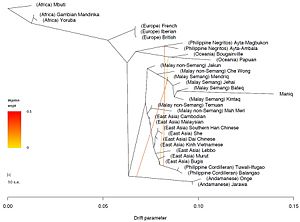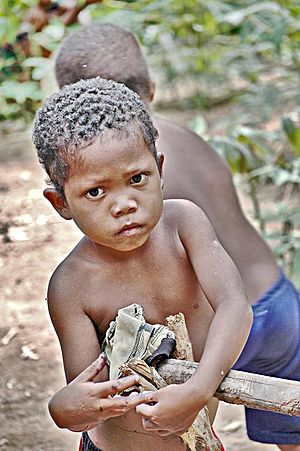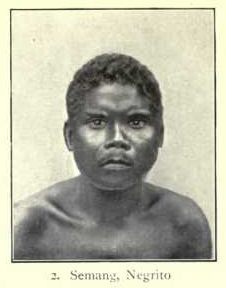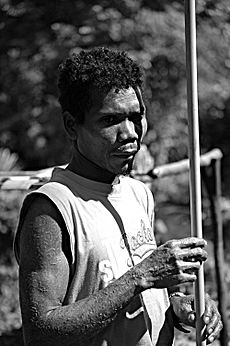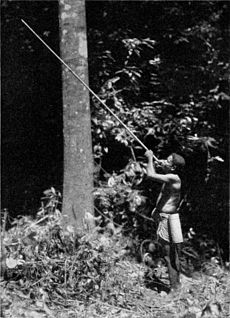Semang facts for kids
| Sakai / Pangan / Ngò' Pa | |
|---|---|
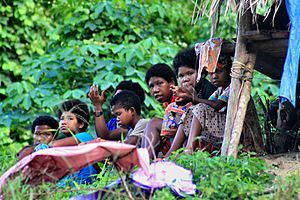
|
|
| Total population | |
| Approximately 4,596 | |
| Regions with significant populations | |
| Malay Peninsula: | |
| Approximately 2,000–3,000 | |
| 300 | |
| Languages | |
| Jedek language, Batek language, Lanoh language, Jahai language, Mendriq language, Mintil language, Kensiu language, Kintaq language, Ten'edn language, Thai language, Malay language, English language | |
| Religion | |
| Animism and significant adherents of Christianity, Islam, Buddhism or Hinduism | |
| Related ethnic groups | |
| Orang Asli (Proto-Malay, Senoi, Batek, Jahai, Lanoh, Maniq, Andamanese) | |
The Semang are a group of people living in the Malay Peninsula. They live in the mountains and forests of Perak, Pahang, Kelantan, and Kedah in Malaysia. Some also live in the southern parts of Thailand.
The Semang are known for their dark skin and curly hair. Because of these features, they are sometimes called "Negrito," which means 'little negro' in Spanish. This term is not always liked.
People have known about the Semang since before the 3rd century. They traditionally lived as nomadic hunter-gatherers. This means they moved around to find food.
The Semang are part of a larger group called Orang Asli in Malaysia. This group includes different populations who traditionally hunted and gathered. In the past, the Semang often traded with other local groups. But sometimes, they were also treated badly, raided, or even enslaved. Some Semang people were enslaved for over a thousand years. Others managed to stay hidden in isolated areas.
Contents
- Understanding the Semang Name and Status
- Physical Characteristics of Semang People
- Diverse Semang Ethnic Groups
- Where Semang People Live
- Semang Population Numbers
- Semang Languages and Communication
- A Brief Look at Semang History
- Semang Beliefs and Spirituality
- Semang Culture and Traditions
- How Semang People Make a Living
- Semang Daily Life and Homes
- Semang Society and Community
- Images for kids
- See also
Understanding the Semang Name and Status
The term "Semang" is used in Malaysia to describe these hunter-gatherer groups. They are also sometimes called "Negrito." In the past, some eastern Semang groups were known as "Pangan." In Thailand, they are called "Sakai" or "Ngopa." The term "Sakai" is seen as insulting in Malaysia.
In Malaysia, the Semang are one of three main groups of Orang Asli. The other two groups are the Senoi and the Proto-Malay. The Semang themselves have six main subgroups: Kensiu, Kintaq, Lano, Jahai, Mendriq, and Batek.
The Malaysian government has a special department called the Department of Orang Asli Development (JAKOA). This department helps the Orang Asli groups, including the Semang, to become part of the wider Malaysian society.
The way these groups are divided comes from the British colonial times. It was based on ideas about different "races." The "Negrito" (Semang) were seen as the most traditional hunter-gatherers. The Senoi were thought to be more developed, and the Proto-Malay were seen as similar to the Malay Muslims.
In Thailand, the royal family has shown support for the Semang people.
Physical Characteristics of Semang People
Semang people usually have dark skin and often curly hair. They also have Asiatic facial features and a strong, sturdy build.
Diverse Semang Ethnic Groups
The Semang people do not see themselves as one single group. They prefer to use their own tribe names. The name "Semang" is used by people outside their communities.
In Malaysia, there are at least ten tribes known as "Semang." Not all of them are officially recognized by the government. Here are some of them:
- Kensiu: They live in northern Kedah, near the border with Thailand. Many live in Kampung Lubuk-Legong, Baling District, Kedah.
- Kintaq: They have one village near Gerik in Hulu Perak District, Perak. They used to move around Klian Intan and near Baling District.
- Lanoh: They live in three villages in the Hulu Perak District in northwest Perak. This group includes other smaller groups like the Semnam and Sabub'n.
- Jahai: They live in the mountains between Perak and Kelantan, south of the Thai border. They often settle near rivers or lakes.
- Mendriq: They live in villages along the Kelantan River in the Gua Musang District of southern Kelantan.
- Batek: This group has different parts, like the Bateg Deq and Bateg Nong. They live in southern Kelantan, Terengganu, and Pahang. The Mintil tribe is also considered part of the Batek.
A few smaller Semang groups also live in southern Thailand. These nomadic groups are known by names like Tonga, Mos, Chong, and Ten'en. They call themselves Mani.
Some of these Semang groups are very small and are in danger of disappearing.
Where Semang People Live
The Semang mainly live in the isolated lowlands and hills within the tropical jungles of the northern Malay Peninsula. Only the Jahai live in higher areas.
In the past, the Semang lived in a wider area. But other groups pushed them into harder-to-reach places. Today, many Semang tribes live in permanent settlements. However, some groups still go into the jungle to gather forest products, especially when wild fruits are ripe. Because of this, they are often called nomads, even though most Semang in Malaysia no longer live a fully nomadic life.
Some Semang, as part of the Orang Asli group, now also live in cities in Malaysia, mixed with other ethnic groups.
There are also isolated Semang groups in the jungles of southern Thailand. They live in provinces like Trang, Phatthalung, Satun, and Yala. Some Thai Semang are settled in villages, while others are still nomadic. They often cross the border freely between Thailand and Malaysia.
The closest neighbors of the Semang are often the Malay people. This is true for both Malaysian and Thai Semang.
Semang Population Numbers
Here's how the Semang population in Malaysia has changed since Malaysia became independent:
| Year | 1960 | 1965 | 1969 | 1974 | 1980 | 1996 | 2000 | 2003 | 2010 |
|---|---|---|---|---|---|---|---|---|---|
| Kensiu | 126 | 76 | 98 | 101 | 130 | 224 | 254 | 232 | 280 |
| Kintaq | 256 | 76 | 122 | 103 | 103 | 235 | 150 | 157 | 234 |
| Lanoh | 142 | 142 | 264 | 302 | 224 | 359 | 173 | 350 | 390 |
| Jahai | 621 | 546 | 702 | 769 | 740 | 1,049 | 1,244 | 1,843 | 2,326 |
| Mendriq | 106 | 94 | 118 | 121 | 144 | 145 | 167 | 164 | 253 |
| Batek | 530 | 339 | 501 | 585 | 720 | 960 | 1,519 | 1,255 | 1,359 |
| Total | 1,781 | 1,273 | 1,805 | 1,981 | 2,061 | 2,972 | 3,507 | 4,001 | 4,842 |
Here's how the Orang Asli subgroups were spread across Malaysian states in 1996:
| Kedah | Perak | Kelantan | Terengganu | Pahang | Total | |
|---|---|---|---|---|---|---|
| Kensiu | 180 | 30 | 14 | 224 | ||
| Kintaq | 227 | 8 | 235 | |||
| Lanoh | 359 | 359 | ||||
| Jahai | 740 | 309 | 1,049 | |||
| Mendriq | 131 | 14 | 145 | |||
| Batek | 247 | 55 | 658 | 960 | ||
| Total | 180 | 1,356 | 709 | 55 | 672 | 2,972 |
In Thailand, the Semang population was about 240 people in 2010.
Semang Languages and Communication
The languages spoken by the Semang are part of the Aslian branch. This branch belongs to the larger Austroasiatic languages family. Other groups like the Senoi also speak Aslian languages.
Aslian languages are divided into four main groups: Northern Aslian, Central Aslian, Southern Aslian, and Jah Hut language.
Many different languages and dialects are spoken among the Semang in Malaysia. Most of these are Northern Aslian languages. The Lanoh language belongs to the Central Aslian group. Not many Semang languages in Thailand have been studied.
A special thing about Semang languages is that they don't have clear borders. This is common for small, nomadic groups who often live together in temporary camps. This means that all the Northern Aslian languages are connected in a big network because people are always in contact.
Some Semang languages and dialects have disappeared completely. Others, like Sabüm language, Semnam language, and Mintil language, are in danger. However, most Semang languages are stable, even with few speakers.
Most Semang people also speak Malay. Many Malay words have entered Semang languages. They also borrow words from each other's languages. In the north, the Kensiu language has many words from the Thai language. In Thailand, most settled Semang also speak Thai. Some Semang can even speak English, partly because Malaysia was ruled by the British for many years.
A Brief Look at Semang History
It is believed that the Semang people first formed in the Malay Peninsula. They came from East Asian groups who moved south from mainland Southeast Asia. These early groups were hunter-gatherers. They also practiced some plant growing. The Semang are thought to be descendants of these ancient people.
Around 4,000 years ago, a type of farming called Slash-and-burn came to the Malay Peninsula. But nomadic hunting and gathering continued. New people also brought Aslian languages to the peninsula. It is thought that the ancestors of the Senoi became farmers, while the ancestors of the Semang continued to gather food.
Later, the Malay Peninsula became an important trading hub. The Semang became suppliers of valuable jungle products like aromatic wood, camphor, rubber, rattan, and gold. They also acted as guardians of the jungle.
The Malay Srivijaya empire had contact with the Negrito people. In 724 AD, two Negrito pygmies were even given as gifts to Malay rulers. Some Negrito people were enslaved until modern times.
In the 14th century, Malay settlers from Sumatra founded trading settlements, like Malacca. As Malay states grew stronger, the relationship with the Semang changed. In the 18th and 19th centuries, the Semang were sometimes captured as slaves. To protect themselves, the Semang learned to avoid outsiders. They would quickly leave their shelters and hide in the jungle if strangers came.
Because they were so isolated, others often saw the Semang as mysterious. Some people in Southeast Asia even thought of them as magical beings. It was once considered special for Malaysian sultans and Thai rulers to have Negritos in their courts.
In the early 1900s, King Chulalongkorn of Thailand met the Semang. In 1906, an orphan Semang boy was even sent to the royal court and became like an adopted son to the king. This led to the royal family supporting the Semang.
The British colonial government later banned slavery. They also tried to protect the Orang Asli. They saw them as "noble savages" who needed protection from modern life.
In the 1950s, during the Malayan Emergency in Malaysia, the government paid more attention to the Orang Asli. A special department, the Department of Orang Asli Affairs (JHEOA), was set up. Its goal was to provide education, health care, and help the Orang Asli develop.
After Malaysia became independent in 1957, the government continued to influence the Orang Asli. In the 1970s, the department started to create settlements for the Semang. By the late 1980s, much of the jungle was being cleared for plantations. This greatly affected the Semang's traditional way of life.
Many Kintaq, Jahai, Batek, and Lanoh people now live in villages built by the state. They have had to change their way of life and learn some farming.
In Thailand, a "Sakai Village" was set up in 1966 to help the Semang. A rubber plantation was created for them. In the 1990s, this village became a tourist center where Semang people would show their traditional way of life.
Semang Beliefs and Spirituality
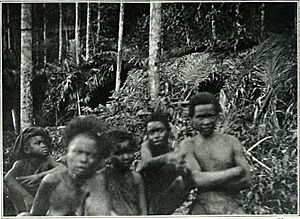
The Semang are animists. This means they believe that not only people, but also all natural objects, have souls.
They imagine the Earth as a flat disk resting on a giant snake or turtle underground. The Earth is connected to the sky by stone pillars. Their world is full of immortal spirits living in the sky, in the pillars, and underground. The sky is seen as a paradise with flowers and fruit trees. These spirits created the rainforests to provide for people on Earth.
Most spirits do not have names. They are often linked to natural things like wind or fruit trees. Others have names and special powers. Many Semang are afraid of thunder, floods, and storms. Their main god is Karey, the god of thunder. They fear him because he is seen as cruel and punishes those who break taboos. He can cause death, injury, or sickness with lightning or animal attacks.
Each group has a shaman, called a hala. The shaman acts as a link between the human world and the spirit world. Shamans perform rituals, practice magic, predict the future, heal illnesses, and find safe places for camps. They use herbs and magic spells to treat sickness. Semang believe their shamans can talk to spirits in a trance.
Shamans can be men or women. There are "big" and "small" halas. Small halas know some healing methods, using songs, massage, and herbs. Big halas are believed to have supernatural powers. They can talk to spirits through dreams or trances. They can even turn into tigers to scare away dangerous animals. Shamans get their knowledge from spirits or from other shamans.
Special ceremonies happen for important life events like birth, sickness, and death. There are also rituals related to finding food. Animist symbols are used in these rituals.
The Malaysian government tries to encourage the Orang Asli to become Muslims. By the end of the 20th century, some Semang were considered Muslim. Here are the numbers:
| Кensiu | Кintaq | Jahai | Lanoh | Меndriq | Batek | |
|---|---|---|---|---|---|---|
| Muslims Negritos (1997) | 108 | 67 | 292 | 94 | 61 | 710 |
| Total population (1996) | 224 | 235 | 1 049 | 359 | 145 | 960 |
Semang Culture and Traditions
The Semang practice Scarification. Young boys and girls get scars on their skin in a simple ceremony. This marks the end of their childhood. They use a sugarcane leaf to make cuts, then rub charcoal powder into them.
They have musical instruments made of bamboo, like a jaw harp and a nose flute. During celebrations, they sing and dance. Both men and women decorate themselves with leaves.
The Semang bury their dead on the same day. The deceased person's belongings are placed on a small bamboo rack over the grave. Only important people, like chiefs or great shamans, are buried in trees.
They also use Capnomancy (divination by smoke) to find out if a camp is safe for the night.
Traditional Way of Life
Traditionally, the Semang lived as nomadic hunter-gatherers in the jungle. Each group had its own territory where they moved around to find food. They changed their way of getting food depending on what was available. When one food source ran out, they would find another.
This way of life has continued for thousands of years. Semang families are very independent. They can gather in temporary camps, then split up, and then meet with other families in new camps. This way of life works well for nomadic groups.
Semang people believe that their traditional territories are free for everyone in their local group to use. Some groups believe that poisonous trees and fruit trees they planted or found belong to them. Other groups think these trees are free for all.
The Malaysian government does not officially recognize the Semang's rights to their traditional lands or resources.
Although they are often called "deep jungle" people, Semang actually live in areas between jungles and farms. This area has many different resources. They can also collect valuable wood and trade with their neighbors. In the deep jungle, they mostly hunt small animals.
In state-built villages, the Department of Orang Asli Development tries to encourage Semang to farm. They plant rubber trees, durian, and other crops. The Semang have to adapt to these new ways. Farming takes a long time to see results, which is different from their traditional way of life.
Sometimes, Semang groups go to gather forest products, trade them, or work for Malay farmers. They might also fish or ask for gifts from visitors.
To help them, JAKOA gives them food. But if the food is delayed, the Semang might stop farming and return to the jungle. Gathering jungle products for sale is still very important to them. Working for money, farming, and gardening come after that.
How Semang People Make a Living
The Semang traditionally made a living by gathering, hunting, and fishing. They also traded goods. Only in the 20th century did some groups, especially the Lanoh and Batek, start to practice Slash-and-burn farming.
For daily food, they collect roots and fruits from wild plants in the jungle. Wild yams are a main food source. They also gather bamboo shoots, nuts, seasonal fruits, mushrooms, and honey. They also find medicinal herbs.
They use different jungle products for many things. Bamboo is used for building homes, blowguns, darts, fish traps, and cooking tools. Wood is used for knife handles and cutting boards. Pandan leaves are used for mats and baskets. Tree bark is used for baskets and clothing. Rattan is used for rope, baskets, ladders, and belts.
The Semang spend a lot of time gathering jungle products to sell or trade with Malay villages. These include wild fruits like petai and durian, as well as rattan, rubber, wax, honey, and herbs. They use the money from these sales to buy rice, oil, tobacco, salt, sugar, clothes, knives, and other supplies.
They hunt with spears, rifles, and slingshots. Their main weapon is the blowgun, which they use for small animals like squirrels, monkeys, and birds. They use poisoned darts with the blowgun. Guns and spears are used for larger animals like wild pigs and deer. Sometimes, they set traps. Young men use slingshots for birds and tree animals. In the past, some Semang used bows and arrows for group hunting, but this stopped in the early 1900s.
They catch fish in rivers using special bamboo traps, spears, hooks, and fishing rods.
All the food they get is shared with everyone in the camp.
Some Semang groups have also grown a few cultivated plants like Upland rice, corn, and sweet potatoes. They practiced simple farming on small cleared areas of the jungle. The harvest belongs to the family who planted it, but the food is usually shared with everyone.
The Semang do not make pottery or weave cloth. They get steel knives and axes through trade or by reshaping metal waste. There is not much specialization of jobs, except for religious roles.
Women usually gather food and farm. Men usually go hunting.
Semang Daily Life and Homes
Until recently, most Semang lived a nomadic life. They stayed in temporary camps with simple shelters. These shelters were usually palm straw shields that leaned against sticks. They protected people from wind and rain. Each shelter housed a couple, a widow, or a group of unmarried young people.
Some western Semang groups would place their lean-to shelters in two rows facing each other. This created a long, shared hut like a tunnel.
The Semang also lived in caves or shelters formed by tree branches. Sometimes, they built circular homes with a central space for meetings, dancing, and ceremonies. For short stays, they would use caves or groups of trees for shelter overnight.
Settled Semang now live in small bamboo or straw huts built on stilts. Villages built by the state have typical Malay-style wooden huts. These villages have basic things like roads, electricity, water, and schools.
Traditionally, Semang tribes built their homes very close together. A problem from their nomadic past is that they used to leave garbage around their huts. Now, in settled villages, this can lead to health problems because people live near their own waste.
Traditionally, Semang had very few household items because they had to carry everything with them. Their homes, tools, and dishes were often made for single use.
The traditional clothing for Semang men is a loincloth made from tree bark. Women wear short skirts made of the same material. These skirts are decorated with bamboo pieces in patterns that are believed to protect them from sickness. Women also tattoo and paint their faces.
Semang Society and Community
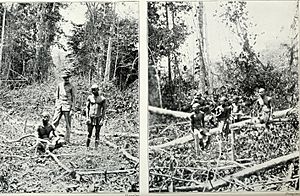
Semang people lived in small family groups of 15-50 people. They did not have a strict tribal organization. The jungle could not feed very large groups. There were no fixed groups or memberships based on ideas. Many camps were made up of one or more extended families, but these were only temporary.
The most stable group in Semang society is the nuclear family: a man, a wife, and their children. The family usually lives in its own home. Older children might build their own homes nearby. Families work together to find food, and adults teach children life skills and cultural values.
Kinship is traced through both the father's and mother's sides. Semang do not distinguish between relatives and cousins, but they do separate older and younger siblings.
Young people usually choose their own spouses. Parents have little say in this. A future husband might ask the girl's parents for permission, but not always. The marriage ceremony is very simple. It often involves just the couple, who might have a small celebration. Some groups have the groom bring gifts to the bride's parents. A marriage is official when the couple starts living together.
Groups are exogamous. This means marriages between close blood relatives are not allowed. This rule makes people marry into distant groups, creating a large network of social connections.
Divorce is common, especially if a couple has no children. It's usually simple: the couple just stops living together. Conflicts are rare, and former spouses often remain friends in the same camp.
Young children usually stay with their mother after a divorce. Older children choose who to live with and often move between parents. Fathers and stepmothers usually treat children from previous marriages as their own. A Semang man can remarry if his wife dies or they divorce, but he usually has only one wife at a time.
The nuclear family is also the main economic unit. Women play an important role by providing food from the jungle and rivers. A pregnant woman or a woman with a baby cannot work as much and is less mobile. Caring for children also takes time and needs more food. Children traditionally did not have "economic value" in the Semang community. They mostly played during the day.
When Semang people started living in settled villages, their birth rate increased quickly. Farming needs more workers, and women no longer face the problem of caring for children while moving. Also, food stamps that children get at school have become important for families and have changed how children are seen in society.
Semang society is egalitarian. This means everyone is seen as equal. People are connected by family and friendship. There are no social classes. No adult has power over another adult. People respect individual freedom. Bad behavior is discouraged, and people believe that spirits will punish those who break rules. Semang generally dislike violence. Disputes are solved through public discussion until everyone agrees. If people don't get along, they might simply leave the camp.
Some charismatic people, both men and women, might have some influence. They can become informal leaders in certain situations, but they don't have real power. Such a leader is called a penghulu, a Malay term. Some penghulu (only men) are appointed by the Department of Orang Asli Development. They act as a link between the group and outsiders but have no power within the group.
A penghulu receives wages from the department. They are formally chosen by a group of men. Women also share their opinions, even if they don't vote directly. The position of penghulu is often passed down to the eldest son. If the department doesn't like the current penghulu, they might pressure the group to choose someone else.
Images for kids
See also
 In Spanish: Semang para niños
In Spanish: Semang para niños
- Maniq people
- Australian Aborigines
- Papuan peoples
- Melanesians
- Orang Asli Museum


